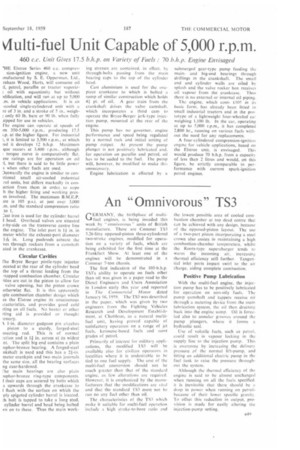An "Omnivorous" TS3
Page 83

If you've noticed an error in this article please click here to report it so we can fix it.
GERMANY, the birthplace of multifuel engines, is being invaded this week by " omnivorous " units of British manufacture. These are Commer TS3 3.26-litre opposed-piston three-cylindered two-stroke engines, modified for operation on a variety of fuels, which are being exhibited for the first time at the Frankfurt Show. At least one of the engines will be demonstrated in a Commer 7-ton chassis.
The first indication of the 105-b.h.p. TS3's ability to operate on fuels other than oil was given in a paper read to the Diesel Engineers and Users Association in London early this year and reported in The Commercial Motor dated January 16, 1959. The TS3 was described in the paper, which was given by two engineers from the Fighting Vehicles Research and Development Establishment, at Chobham, as a natural multifuel unit, having proved capable of satisfactory operation on a range of jet fuels, kerosene-based fuels and most grades of petrol.
Primarily of interest for military applications, the modified 1 S3 will be available also for civilian operators in localities where it is undesirable to he tied to one fuel supply. The cost of the multi-fuel conversion should not he much greater than that of the standard engine, as few alterations are required. However, it is emphasized by the manufacturers that the modifications are vital and that the standard 153 must not he run on any fuel other than oil.
The characteristics of the TS3 which make it suitable for multi-fuel operation 'include a high stroke-to-bore ratio and the lowest possible area of cooled corn bustion chamber at top dead centre that can be achieved with any design, because of the opposed-piston layout. The use of a two-part piston incorporating a steel crown also assists in maintaining a high combustion-chamber temperature. whilst the Roots-type supercharger tends to warm the incoming air, increasing thermal efficiency still further. Tangential inlet ports impart swirl to the air charge, aiding complete combustion.
Positive Pump Lubrication
With the multi-fuel engine, the injection pump has to be positively lubricated for operation on non-oily fuels. The pump camshaft and tappets receive oil through a metering device from the main lubrication system, the oil then draining back into the engine sump. Oil is forcefed also to annular grooves around the pump plungers, where it forms a hydraulic seal.
Use of volatile fuels, such as petrol. could result in vapour locking in the supply line to the injection pump. This is overcome by increasing the delivery pressure ,of the normal lift-pump, and fitting an additional electric pump in the fuel tank to raise the pressure throughout the system.
Although the thermal efficiency of the engine is said to be almost unchanged when running on all the fuels specified. it is inevitable that there should be e drop in power when running on petrol because of their lower specific gravity. To offset this reduction in output, provision is made for easily altering the injection-pump setting.




































































































































